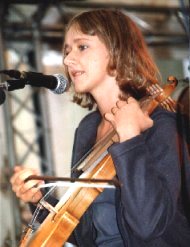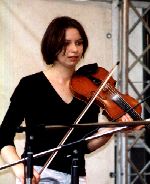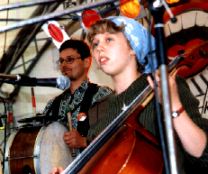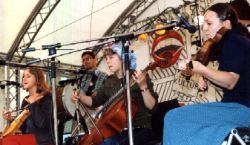FolkWorld article by Michael Moll:
Music of the village of Warsaw
'Kapela ze wsi Warzsawa' presenting fresh roots from Poland
 Poland, being already with one foot in the European Union, is still a country widely unknown in the European folk music scene. And that although there is currently in Poland a very vibrant folk music scene. Kapela ze wsi Warzsawa is one of the magnificent bands that Poland has produced, and this young innovative band was this summer guest at the Tanz & Folk Fest Rudolstadt. We took this opportunity to talk for FolkWorld a bit with Maciej, drum player in the band, about the Polish folk music scene.
Poland, being already with one foot in the European Union, is still a country widely unknown in the European folk music scene. And that although there is currently in Poland a very vibrant folk music scene. Kapela ze wsi Warzsawa is one of the magnificent bands that Poland has produced, and this young innovative band was this summer guest at the Tanz & Folk Fest Rudolstadt. We took this opportunity to talk for FolkWorld a bit with Maciej, drum player in the band, about the Polish folk music scene.
Folk music is at the moment highly popular in Poland, being kind of fashionable. The scene exists only since the beginning of the 90's, as Maciej explains. There are currently around 90 different bands, that can be split roughly into three sectors: "There are those groups reconstructing folk music in its traditional authentic way. Then there are those introducing modern and ethnic elements into the traditional music; currently 'Kapela ze wsi Warzsawa' is probably the only band creating something like this. Finally there are groups that also use instruments from other countries and cultures and experiment with them, but that are pretty commercialised and play more kind of mainstream."
 There are also a lot of festivals in Poland, mostly not too big though. There is for example in Zabkowice Slaskie a festival that is a kind of little brother of the TFF Rudolstadt and takes place the same weekend. The importance that folk and world music has at the moment in Poland is very well represented in the fact, that one of the biggest Pop Festivals dedicates since last year its first day to ethnic music.
There are also a lot of festivals in Poland, mostly not too big though. There is for example in Zabkowice Slaskie a festival that is a kind of little brother of the TFF Rudolstadt and takes place the same weekend. The importance that folk and world music has at the moment in Poland is very well represented in the fact, that one of the biggest Pop Festivals dedicates since last year its first day to ethnic music.
Parallely to the festival circuit, there is an alternative music scene, far away from mainstream and media attention. It is a very broadly understood independent scene, uniting not only folk but also e.g. punk and hardcore, that organises concerts in clubs.
Already in the 70s and 80s there were a couple of bands around playing folk music with influences from diverse cultures. At that time, those bands just played without quite anybody in Poland knowing of them; these bands played mainly outside of Poland. Maciej believes that the most important development in the Polish scene has been the start of the Saint Nicholas Orkiestra in 1990. "They played music that was very lively interpreted in a distinctive Polish way. This band has basically kicked off the whole scene, and brought folk music into the focus of the student's scene. The Saint Nicholas Orkiestra presented a music style that bases on old instruments which are usually no longer used. These musicians started to find old instruments in the villages, and looked for people who knew how to play them. They were inspired by diverse traditions, Polish music, Klezmer and Yiddish music, music from the Polish mountains, Balkan music. These days, the band is quite far away from pure traditional music..."
 The old people who still know how to play the old instruments for also the main inspiration for the musicians of the 'Kapela ze wsi Warzsawa', most of them having learnt the music auto-didactically with the help of these people. "We travelled to the little villages and visit the old people, listened to their music and their stories. And we were actually very surprised finding out that on the villages nobody is these days still interested in the music. With the old people the music will die out."
The old people who still know how to play the old instruments for also the main inspiration for the musicians of the 'Kapela ze wsi Warzsawa', most of them having learnt the music auto-didactically with the help of these people. "We travelled to the little villages and visit the old people, listened to their music and their stories. And we were actually very surprised finding out that on the villages nobody is these days still interested in the music. With the old people the music will die out."
Only because of those old people they know how to play the instruments the traditional way. "They have taken the time and effort to teach us their knowledge, because they thought, if they would not hand it down to us, nobody would do it. We got the feeling of being something like the selected ones who have to keep up the music traditions. And that this is the only chance to preserve the traditions."
The music of the 'Kapela ze wsi Warzsawa', meaning translated "The band from the village called Warsaw", is something new for most Polish. When they sat together for the first time, playing on drums and fiddles, they astonished the people. "No person in Warsaw had ever heard this kind of music."
The most interesting instrument of the Kapela is without doubt the Suka, played by Anna, an old unique Polish type of fiddle from the 16th century, with its strings being played with the finger nails. The other three girls in the band play violin and cello, while the two men play (hand) drums.
 The girls sing with very powerful voices; sometimes the singing sounds a bit shrill, but always full of power, passion and fascination. "The singing has its roots in the so called "white voice", a special and old technique of singing that comes from the shepherds."
The girls sing with very powerful voices; sometimes the singing sounds a bit shrill, but always full of power, passion and fascination. "The singing has its roots in the so called "white voice", a special and old technique of singing that comes from the shepherds."
Together with the traditional playing techniques on old Polish instruments, this musical combination is pretty much unique in Poland. Especially the use of two drums is exceptional; and it is essential to note that both the drums and the rhythms are traditional Polish. "The rhythm is the typical and most important part", explains Maceij. "We want to show that it does not always have to be the typical drum kit, but that there are also European instruments that can absolutely fulfil this function, and that we should be proud of. People are enthusiastic about exotic and strange cultures, but they do not know that there are such instruments also in Europe. In the confrontation with and the taking over of elements of other cultures we start to loose these instruments and with it our heritage."
When the band came together in 1997 for the first time, the musicians started to play a traditional rhythm as long - 40 minutes or longer - until they would have found a kind of sound image. For Maceij this music is something like a drug for the soul, both for musicians and listeners. With the time, more and more people became interested in their music, and after playing only for private functions, they were contacted also by festivals and managers. "We had to do something - we could not always play for 40 minutes the same rhythm; so we started to play diverse combinations." The range of instruments has always stayed the same, and the band has always stayed true to the traditional Polish acoustic instruments.
Two years ago, the Kapela recorded their debut CD, landing a kind of a record: They have recorded the 60 minutes of the CD during one day, going into the studio and playing until the CD was completed. "These are just sounds that come naturally out of the hands."
 Somehow the sound of the Kapela reminds of Scandinavian music - there is this dark beauty, the raw energy, but also the arrangements and that special kind of feeling in the music. IS there any relation between the Kapela or the Polish tradition in general to the opposite shore of the Baltic Sea? "You can find in Poland a big fascination for Swedish folk bands such as Garmana, Hedningarna, Hoven Droven. Swedish bands are often highly influential; they experiment very much; their music sounds very characteristic. The Scandinavian scene is very well-known in Poland. But there are also traditionally links between Poland and Sweden. Poland was occupied by the Swedes in the 17th century. There were always a lot of people travelling over; there was always cultural exchange between the two countries. The classic Swedish dance, the Polska, came from Poland, and it is based upon the Polish polka...."
Somehow the sound of the Kapela reminds of Scandinavian music - there is this dark beauty, the raw energy, but also the arrangements and that special kind of feeling in the music. IS there any relation between the Kapela or the Polish tradition in general to the opposite shore of the Baltic Sea? "You can find in Poland a big fascination for Swedish folk bands such as Garmana, Hedningarna, Hoven Droven. Swedish bands are often highly influential; they experiment very much; their music sounds very characteristic. The Scandinavian scene is very well-known in Poland. But there are also traditionally links between Poland and Sweden. Poland was occupied by the Swedes in the 17th century. There were always a lot of people travelling over; there was always cultural exchange between the two countries. The classic Swedish dance, the Polska, came from Poland, and it is based upon the Polish polka...."
Further infos/contact: homepage of the band.
Photo Credit: All photos by The Mollis.
WIN Polish Folk Sampler "A Musical Journey to Poland"
"A Musical Journey to Poland" is a high quality sampler in the series "Travellin' Companion" of the German Weltwunder label, and features 14 titles of the new Polish Folk Scene. That album, featuring also a title of the Kapela, is highly recommended. A full review is found in the review section.
To take part in the competition, name us at least three other Polish Bands of the New Folk Scene.
Answers until 20/2/2001 to FolkWorld.
Back to the content of FolkWorld Articles, Live Reviews & Columns
To the content of FolkWorld online magazine Nr. 17
© The Mollis - Editors of FolkWorld; Published 12/2000
All material published in FolkWorld is © The Author via FolkWorld. Storage for private use is allowed and welcome. Reviews and extracts of up to 200 words may be freely quoted and reproduced, if source and author are acknowledged. For any other reproduction please ask the Editors for permission.
FolkWorld - Home of European Music

Layout & Idea of FolkWorld © The Mollis - Editors of FolkWorld
 Poland, being already with one foot in the European Union, is still a country widely unknown in the European folk music scene. And that although there is currently in Poland a very vibrant folk music scene. Kapela ze wsi Warzsawa is one of the magnificent bands that Poland has produced, and this young innovative band was this summer guest at the Tanz & Folk Fest Rudolstadt. We took this opportunity to talk for FolkWorld a bit with Maciej, drum player in the band, about the Polish folk music scene.
Poland, being already with one foot in the European Union, is still a country widely unknown in the European folk music scene. And that although there is currently in Poland a very vibrant folk music scene. Kapela ze wsi Warzsawa is one of the magnificent bands that Poland has produced, and this young innovative band was this summer guest at the Tanz & Folk Fest Rudolstadt. We took this opportunity to talk for FolkWorld a bit with Maciej, drum player in the band, about the Polish folk music scene.
 There are also a lot of festivals in Poland, mostly not too big though. There is for example in Zabkowice Slaskie a festival that is a kind of little brother of the TFF Rudolstadt and takes place the same weekend. The importance that folk and world music has at the moment in Poland is very well represented in the fact, that one of the biggest Pop Festivals dedicates since last year its first day to ethnic music.
There are also a lot of festivals in Poland, mostly not too big though. There is for example in Zabkowice Slaskie a festival that is a kind of little brother of the TFF Rudolstadt and takes place the same weekend. The importance that folk and world music has at the moment in Poland is very well represented in the fact, that one of the biggest Pop Festivals dedicates since last year its first day to ethnic music. The old people who still know how to play the old instruments for also the main inspiration for the musicians of the 'Kapela ze wsi Warzsawa', most of them having learnt the music auto-didactically with the help of these people. "We travelled to the little villages and visit the old people, listened to their music and their stories. And we were actually very surprised finding out that on the villages nobody is these days still interested in the music. With the old people the music will die out."
The old people who still know how to play the old instruments for also the main inspiration for the musicians of the 'Kapela ze wsi Warzsawa', most of them having learnt the music auto-didactically with the help of these people. "We travelled to the little villages and visit the old people, listened to their music and their stories. And we were actually very surprised finding out that on the villages nobody is these days still interested in the music. With the old people the music will die out." The girls sing with very powerful voices; sometimes the singing sounds a bit shrill, but always full of power, passion and fascination. "The singing has its roots in the so called "white voice", a special and old technique of singing that comes from the shepherds."
The girls sing with very powerful voices; sometimes the singing sounds a bit shrill, but always full of power, passion and fascination. "The singing has its roots in the so called "white voice", a special and old technique of singing that comes from the shepherds." Somehow the sound of the Kapela reminds of Scandinavian music - there is this dark beauty, the raw energy, but also the arrangements and that special kind of feeling in the music. IS there any relation between the Kapela or the Polish tradition in general to the opposite shore of the Baltic Sea? "You can find in Poland a big fascination for Swedish folk bands such as Garmana, Hedningarna, Hoven Droven. Swedish bands are often highly influential; they experiment very much; their music sounds very characteristic. The Scandinavian scene is very well-known in Poland. But there are also traditionally links between Poland and Sweden. Poland was occupied by the Swedes in the 17th century. There were always a lot of people travelling over; there was always cultural exchange between the two countries. The classic Swedish dance, the Polska, came from Poland, and it is based upon the Polish polka...."
Somehow the sound of the Kapela reminds of Scandinavian music - there is this dark beauty, the raw energy, but also the arrangements and that special kind of feeling in the music. IS there any relation between the Kapela or the Polish tradition in general to the opposite shore of the Baltic Sea? "You can find in Poland a big fascination for Swedish folk bands such as Garmana, Hedningarna, Hoven Droven. Swedish bands are often highly influential; they experiment very much; their music sounds very characteristic. The Scandinavian scene is very well-known in Poland. But there are also traditionally links between Poland and Sweden. Poland was occupied by the Swedes in the 17th century. There were always a lot of people travelling over; there was always cultural exchange between the two countries. The classic Swedish dance, the Polska, came from Poland, and it is based upon the Polish polka...."
